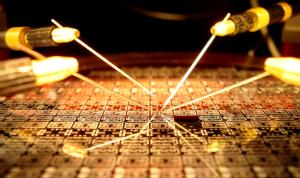John Halpin
computers of the future
What got you interested in this area of science?
When I was young I was fascinated by how computers work and electronics in general. After doing a BSc in astrophysics, it was a breath of fresh air to do something very hands on with so many useful applications! http://www2.warwick.ac.uk/fac/sci/physics/research/condensedmatt/silicon/research/
How is the work you are currently doing relevant to everyday life?
Examples of technology that would not be possible without semiconductor physics are all around us: From the chips in our phones, games consoles and computers to the photovoltaics (solar panels) producing our electricity. The production of semiconductors is the world’s biggest industry, with a worth of approximately $250 billion. The research done at the NanoSilicon group should lead to faster, cheaper and more efficient computers.
The Nanosilicon group also develops new and novel technologies such as:
- On-chip milliKelvin Electronic Refrigerators (For cooling a payload called a Transition Edge Sensor (TES) that gives unsurpassed ability to detect black holes or early stage cancer!)
http://www2.warwick.ac.uk/fac/sci/physics/research/condensedmatt/silicon/research/cooltronics/
-Silicon Photonics (Using light to provide faster and more efficient communication between devices)
http://www2.warwick.ac.uk/fac/sci/physics/research/condensedmatt/silicon/research/photonics/
- Terahertz Quantum Cascade Lasers (potential applications which include oncology (skin cancer imaging), security imaging, production monitoring and astronomy)
http://www2.warwick.ac.uk/fac/sci/physics/research/condensedmatt/silicon/opportunities/qcl
What does your research hope to achieve?
As current technology reaches a limit, new ideas are needed to increase the performance of semiconductor devices. The NanoSilicon group researches the use of new materials and device designs to push the limits of devices for a new generation of applications.
Briefly, what does the image show?
MOSFET’s are the building blocks of the chips that power our electrical devices. The picture shows germanium MOSFET’s being tested on a probing station. Germanium MOSFET’s can give performance far higher than that obtained from the MOSFET’s using the current industry standard of silicon http://www2.warwick.ac.uk/fac/sci/physics/research/condensedmatt/silicon/research/ge/

